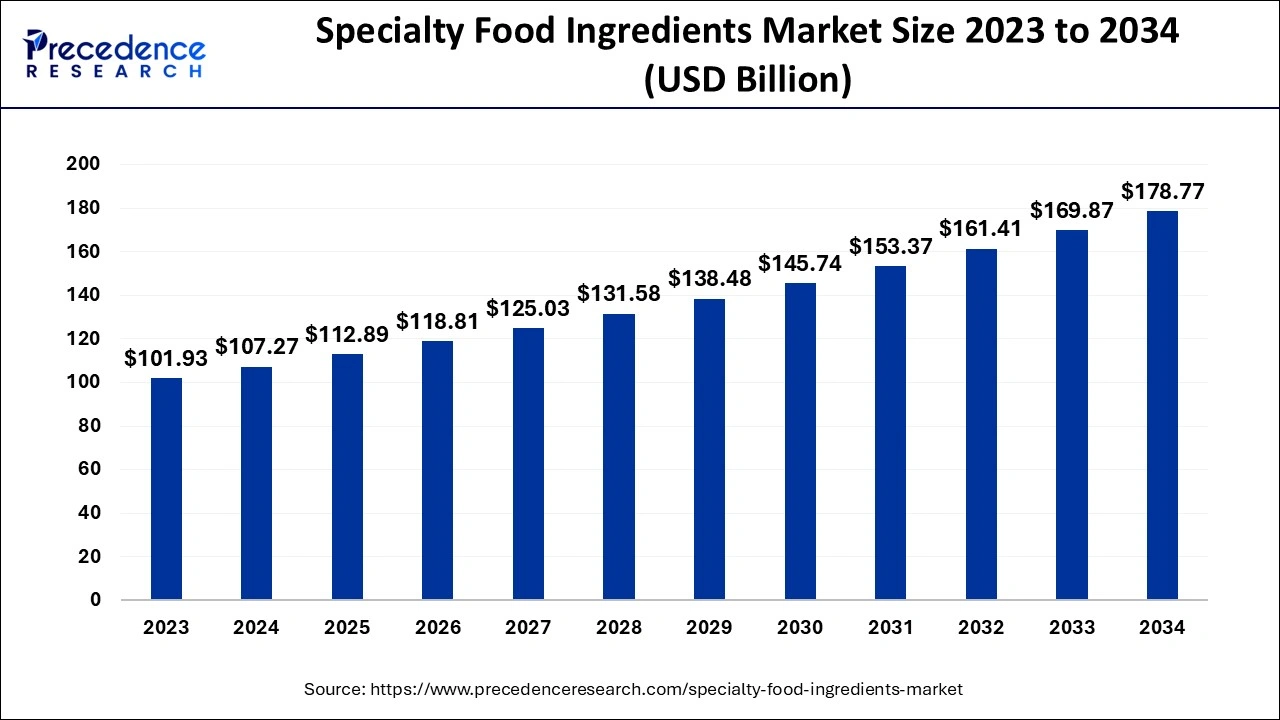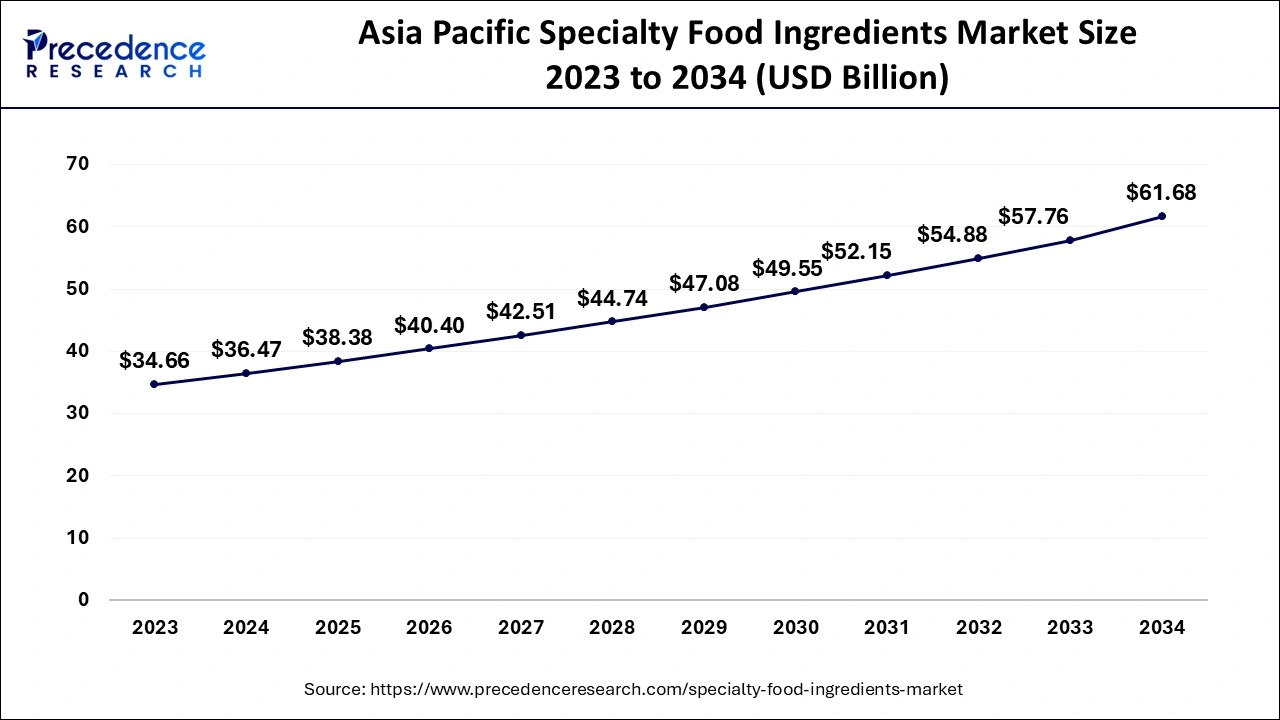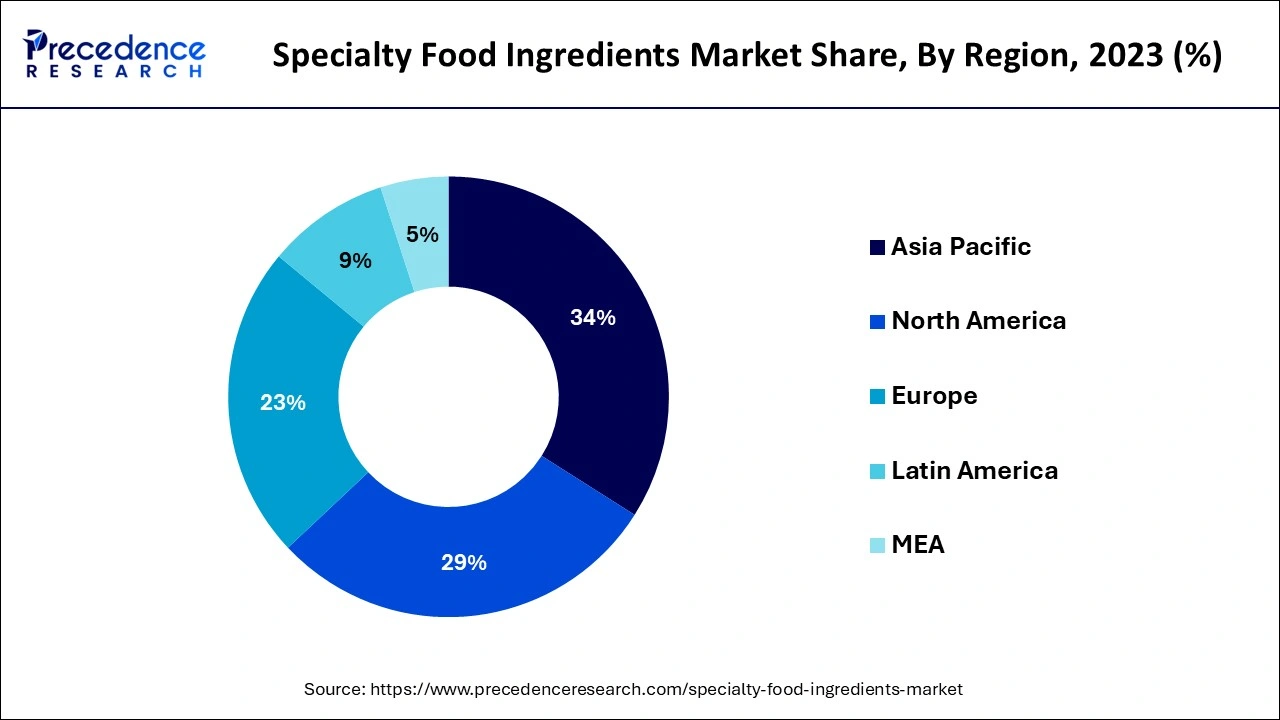October 2024
The global specialty food ingredients market size accounted for USD 107.27 billion in 2024, grew to USD 112.89 billion in 2025 and is predicted to surpass around USD 178.77 billion by 2034, representing a healthy CAGR of 5.24% between 2024 and 2034.
The global specialty food ingredients market size is accounted for USD 107.27 billion in 2024 and is anticipated to reach around USD 178.77 billion by 2034, growing at a CAGR of 5.24% from 2024 to 2034.

The Asia Pacific specialty food ingredients market size is evaluated at USD 36.47 billion in 2024 and is predicted to be worth around USD 61.68 billion by 2034, rising at a CAGR of 5.38% from 2024 to 2034.

Canada will become a significant market in North America over the coming years as a result of the changing customer demands forcing the food industry to assess market conditions, increase its focus on innovations, and create new products. Due to the rising use of soft drinks, juice drinks, and energy drinks that encourages the usage of acidulants, the U.S. market will do incredibly well in the upcoming years. Due to its significance in the creation of soft drinks, citric acid is a key acidulant used by food producers in the US. In North America, the market for artificial food coloring is heavily controlled. Both the Canadian and U.S. governments have implemented batch certification programs to guarantee that all food coloring adheres to high standards of quality. The market for food tastes exhibits strong growth potential due to the sharp increase in consumer demand for processed and functional foods. The region's market is also being driven by customers' changing food patterns and the increased incidence of busy lives.

Europe is considered as second largest region in the consumption of specialty food ingredients market. This region includes UK, Germany, and France. Specialty food ingredients are crucial for offering the customer of today a wide variety of tasty, secure, healthy, economical, high-quality foods that are sustainably produced. They are a crucial component of the European food industry, employed in a large number of consumer items and subsequently ingrained in daily life.
Moreover, countries like Russia, UK, Germany, France, Spain, Italy, are the well-established markets for food acidulants. The primary reasons expected to boost the market expansion in Europe are the rise in food preservation concerns and the practical advantages provided by acidulants to preserve food for a long time.
The malt-based juices work as energizing alternatives to standard soft drinks and thirst-quenchers. Additionally, health-conscious customers in China and Japan prefer natural ingredients in their energy drinks, which has prompted the launch of new products and ingredient improvements and accelerated market growth in the Asia-Pacific region.
Specialty food ingredients are substances that are added to food and drinks to either improve the flavor or boost the nutritional content of the meal or beverage. Specialty food additives are used specifically for food coloring, texture, blending, and preservation. The nutritional value of the food and processed food is improved by the ingredients. The rising need for specialty food ingredients is thought to be the cause of the rising demand for processed meals and convenience foods. With the use of specialty food ingredients, a wide variety of high-quality, secure, delectable, and healthful foods are produced.
Specialty ingredients play a crucial role in the safety of many processed foods. Various macronutrients including carbs, fibers, fats, and different types of proteins, as well as micronutrients like vitamins, enzymes, and minerals, all perform a number of functional activities that improve the quality and flavor of the diet. Specialty food components contribute to the production of healthier foods by enhancing color, emulsifying, preserving texture, and elevating processing. Such items' nutritional, technological, and health-related features make the diet suitable for consumption—safe, delectable, economical, and healthful. Therefore, these advantages of specialty food ingredients will encourage industry expansion on a global scale.
Moreover, the expansion of specialty food ingredients is being indirectly boosted by ongoing improvements in the technologies used to make food and beverages. The market for specialty food ingredients is expanding along with the demand for packaged foods and beverages as a result of changing consumer lifestyles and an ever-increasing population. Increased spending on R&D to innovate and create healthier alternatives would boost market value once more. The demand for the category is being driven by customers who are becoming more concerned with eating a healthy diet. Due to their busy lifestyles and convenience, ready-to-eat foods are becoming more and more popular with consumers.
Consumers' eating habits have changed as a result of their hectic lifestyles, and they now rely more on bakery and confectionary specialty food ingredients market. The rising population across globe and demands for specialty food has become a trend in the market that supports the growth of the specialty food ingredients market.
| Report Coverage | Details |
| Market Size in 2024 | USD 107.27 Billion |
| Market Size by 2034 | USD 178.77 Billion |
| Growth Rate from 2024 to 2034 | CAGR of 5.24% |
| Base Year | 2023 |
| Forecast Period | 2024 to 2034 |
| Segments Covered | Product Type, Application, Geography |
Depending upon the product type, the enzyme segment is the dominant player and is anticipated to have the biggest impact on specialty food ingredients market. The primary uses of enzymes in the food business include stabilizing and clarifying beverages, speeding up the ripening of meat and dairy products, increasing the size of bread loaves, enhancing product quality and production, altering fats, and tenderizing meats. The food sector is constantly looking for new and inventive ingredients to produce the highest quality goods while optimizing manufacturing methods, costs, and quality. Consequently, the market for food enzymes is expanding as the role of enzymes in the food sector increases.
Moreover, due to its associated qualities, such as its softening and digesting properties, the enzymes segment is currently dominating the market. In order to produce flawless end goods on schedule, many food and beverage firms use enzymes for their quick and precise chemical reactions during the process. Another product category that is utilized by manufacturers is the emulsifier. The growing practice of adding vitamins and antioxidants to edible oils and other food products in order to improve the nutritional content of food is anticipated to stimulate the expansion of the global market for specialty food ingredients.
The broader public's understanding of nutrient-dense foods is rising quickly. This focus on nutrition is linked to rising urbanization, pollution, illnesses, and altered eating patterns. The government's efforts to educate rural residents about nutrition, the rise in the number of educated people and working women, and the lack of time for food preparation have all contributed to the demand for nutrient-dense food.
Although it is anticipated that minerals will continue to be consumers' preferred specialty functional ingredients, sales of preservatives are anticipated to grow at the fastest rate. The function of vitamins like calcium, which helps with vitamin D absorption by cells from the food, is one of the major applications of minerals. Hence, the demand for mineral is expected to rise in the forecast period owning to its applications and benefits associated with it.
During the projected period, the bakery and confectionary segment is anticipated to be the largest in the specialty food ingredients market. One of the top consumer food sectors is the bakery industry. The great majority of people today depend on bread products as vital food staples.
Demand for ready-to-eat foods at affordable prices has increased as a result of urbanization, etc. The majority of the bakery market is made up of bread and biscuits. Bakery, patisserie, and chocolate items are in high demand as a result of consumers' increasingly sophisticated preferences.
Because of the rising demand for convenience foods, producers have an expanding potential to incorporate popular consumer trends into quick, convenient solutions that people can enjoy whenever and wherever. When it comes to food and beverages, convenience is always a priority, but many consumers are unwilling to forgo nutrition. They frequently lack the time to make wholesome food and beverages at home due to cultural upheavals and dynamic lifestyle changes. The data speaks for itself: Instead, people choose already prepared alternatives that can save time without endangering their health goals.
By Product Type
By Application
By Geography
For inquiries regarding discounts, bulk purchases, or customization requests, please contact us at sales@precedenceresearch.com
No cookie-cutter, only authentic analysis – take the 1st step to become a Precedence Research client
October 2024
January 2025
January 2025
September 2024